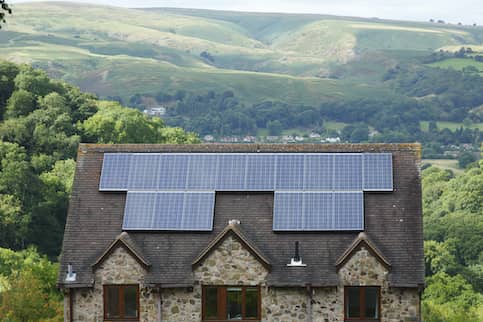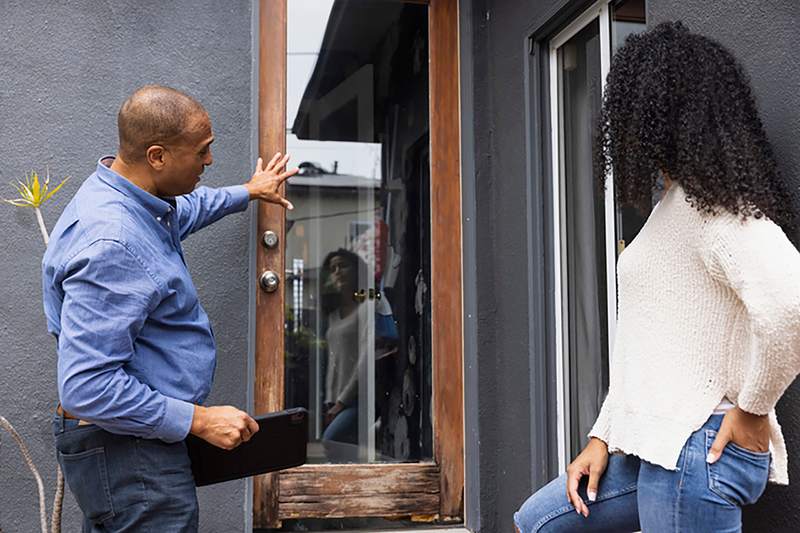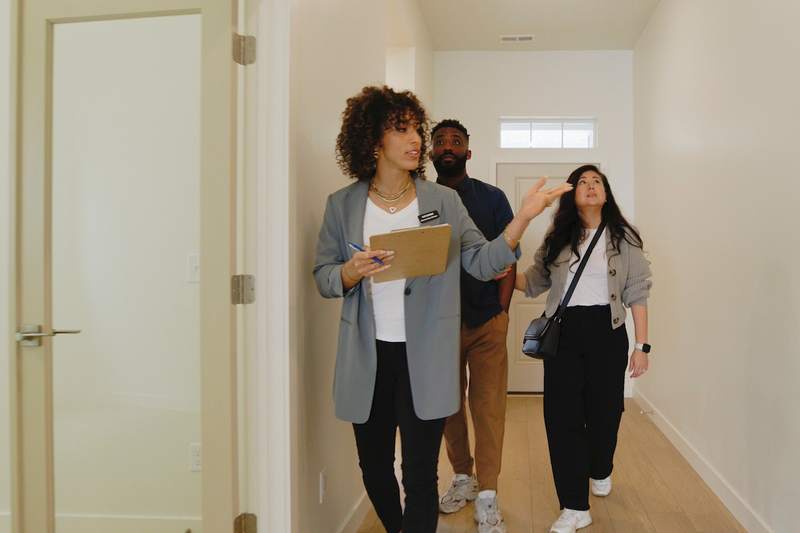Buying a home for the first time can be a bit intimidating for some people. Not only must you find the right home for you, but you’ll need to research neighborhoods, find a real estate agent, likely apply for a mortgage and – in all likelihood – schedule an appraisal and a home inspection.
Fortunately, several real estate and mortgage professionals will be there to help guide you along the way. By understanding how the home buying process works, you may be able to eliminate any unpleasant surprises on your home buying journey.
Let’s walk through some key considerations to keep top of mind when buying a home, including what to prioritize when choosing a neighborhood and the keys to qualifying for the mortgage loan you’ll likely need to finance your home purchase.
What To Look For When Buying A House
Start by considering how large of a home you’ll need. Are you interested in a starter home, or is your family already of a size that you’ll need something bigger? In general, the larger the home, the more you’ll pay. This is why it’s important to determine your monthly housing budget before you start searching for a home.
Before beginning your home search, you’ll also need to determine which style of house is right for you and decide on a neighborhood and school district and whether you want to live more in the city or the suburbs.
What’s Your Goal?
Buy A Home
Discover mortgage options that fit your unique financial needs.

Refinance
Refinance your mortgage to have more money for what matters.
Tap Into Equity
Use your home’s equity and unlock cash to achieve your goals.
Home Buying Process Checklist In 10 Steps
Ready to buy a home? Here are 10 steps that can help you navigate this exciting journey.
1. Determine How Much House You Can Afford
First, you’ll need to determine how much home you can afford. In other words, what’s the most you can comfortably pay for a new home purchase? To figure this out, create your household budget by listing your monthly expenses and income. Be sure to include expenses that change each month, such as the money you spend on transportation, groceries and clothing, as well as leisure – perhaps in the form of restaurant meals, concerts and movies.
Once you’ve calculated your expenses and income, you’ll see how much, if any, extra money you have each month. When buying a home, make sure your monthly mortgage payment – including what you’ll spend on property taxes and homeowners insurance – doesn’t exceed this amount.
When you apply for a mortgage, your lender will consider your debt-to-income ratio (DTI).This number, expressed as a percentage, looks at the relationship between your monthly debt payments and your income. In general, lenders prefer that your monthly debt payments – including your new mortgage payment – equal no more than 50% of your monthly income.
If you want help in determining whether a home is affordable, check out our home affordability calculator.
2. Start Saving For Your Down Payment
Although preferred by many lenders, you don’t typically need a down payment equaling at least 20% of your home’s purchase price. In fact, you might qualify for a conventional loan by putting as little as 3% down. Still, it’s important to start saving for a down payment long before you begin searching for a home so you know this portion is covered in the event that it’s required. (USDA loans and VA loans don’t require a down payment.)
The bigger your down payment, the better off you are financially in the long run. If you come up with a down payment worth 20% or more of your home’s purchase price, you won’t have to pay for private mortgage insurance (PMI) – which is mandatory on a conventional loan if you put down less than 20%. This insurance protects your lender in case you stop making your monthly mortgage payments.
Higher down payments also typically lead to lower mortgage interest rates. This can save you money each month on your payment. Lenders are also typically more willing to approve borrowers who can put more money down.
3. Get Preapproved And Choose A Lender
Applying for a mortgage preapproval from a lender is another key step in buying a home. During the preapproval process, you’ll send proof of your monthly income to a lender. This may include copies of your two most recent paycheck stubs, two months of bank account statements, and your last two W-2 forms and tax returns. This same lender will also check your credit reports and credit score.
The lender will use this information to decide whether it will approve you for a mortgage and, if so, for how much. Then, they’ll send you a preapproval letter stating how large of a mortgage they’re comfortable giving you. This is important because it tells how much home you can afford and lets a seller know you’re serious about buying their home.
Another benefit of getting preapproved by a mortgage lender? It’s free. Just don’t confuse mortgage preapproval with mortgage prequalification. A prequalification is somewhat similar to a preapproval, but you won’t send your lender proof of your income and your lender won’t check your credit.
Instead, lenders will take your information over the phone or by email and then estimate how much they might lend you. Because lenders aren’t verifying your income or checking your credit, a mortgage prequalification is more of an informational service for you, and it’s not a true representation of how large of a mortgage loan you can expect.
Ready To Become A Homeowner?
Get matched with a lender that can help you find the right mortgage.
4. Find A Real Estate Agent
It��’s important to find a real estate agent to help you find the right home. A skilled real estate agent will know the neighborhood where you’re house hunting and let you know when a home you’re considering is priced fairly.
A real estate agent will also help you make your offer and guide the negotiations over the home’s sale price and your move-in date. Best of all, as a buyer, you won’t pay for your real estate agent. Your agent is paid by the sellers, with their proceeds from the home sale.
You should also ask real estate agents for a list of their past customers with whom you can talk. These referrals can tell you if the agent helped them find the right home and helped them negotiate a lower sale price.
5. Start Searching For Your Dream Home
Once you have an agent on your side, it’s time to start looking for your new home in earnest. You can start by scouring the Multiple Listing Service (MLS), an online listing of homes for sale across the country.
You can also tell your real estate agent what type of home you’re looking for, and in what neighborhood or type of neighborhood. If you also give your real estate agent your price point on a home purchase, they’ll send you home listings as they become available. Agents can also point you toward for-sale homes before those homes hit the MLS, giving you the first chance to make an offer.
6. Make An Offer And Negotiate If Needed
Once you find the right home, it’s time to make an offer. Your real estate agent will help you in making an offer and, if necessary, negotiating with the sellers.
After you make an offer, the sellers can either accept it, reject it or make a counteroffer. This last scenario is common and might play out something like this: You offer to pay $250,000 for a home priced at $260,000 but the sellers come back with a counteroffer of $255,000. You might settle on this amount or negotiate even further by making a counteroffer of your own.
Your agent, working with the agent representing the sellers, will lead the negotiations. They’ll work with you on your initial offer and then help you tweak the offer as might be necessary. You might also decide to walk away if you and the sellers can’t agree on a final sale price.
If your offer is accepted, it’s time to work toward closing on your mortgage – unless you’re making an all-cash offer.
7. Consider Hiring A Real Estate Attorney
Some states require that buyers hire a real estate attorney when closing on a mortgage. It’s important to ask your real estate agent or check your state’s laws to determine if you’re buying in one of these states.
Even if your state doesn’t require a real estate attorney during the loan closing, it might make sense to hire one. Real estate attorneys will review your loan documents and your home’s title to make sure there are no errors. If you pay for a real estate attorney to represent you, this legal expert will serve as your advocate during the closing.
Take The First Step To Buying A Home
Find a lender that will work with your unique financial situation.
8. Schedule Your Home Inspection And Appraisal
During a home inspection, an inspector will tour the home to look for problems with the property. The inspector’s report will list any such problems and could include everything from an aging roof and a sinking foundation to signs of termite damage, a hot water heater on its last leg, and signs of mold and water damage.
Once your inspector provides this report, you can request that the sellers fix the problems, provide you the money to hire contractors to fix them, or reduce their asking price. If the inspection reveals certain issues, you might be able to walk away from the sale without any financial penalties.
During a home appraisal, an appraiser will tour your prospective home and consider the sale prices that similar nearby homes have recently fetched. This will help the appraiser determine your prospective home’s current market value. If the appraiser values your home under the price you’ve agreed to pay, the home sale might fall through. Keep in mind: Your lender won’t loan you more money than the home is worth.
9. Prepare For Closing
Once the appraisal is done, it’s time to prepare for the mortgage loan closing. During this process, your lender will send your loan application through the underwriting process, making sure you can afford your new mortgage payment and have a history of paying your bills on time.
You may need to provide your lender with some additional financial documents at this time. You’ll also deal with a number of closing documents, including your Closing Disclosure and Loan Estimate.
Your lender may run a final check of your credit reports and your three-digit FICO® credit score.
10. Close On Your New Home
Finally, you’ll close on your mortgage and take possession of your new home. Closings these days may be held in person or virtually, although in-person closings are typically still preferred. Items you may be responsible for or discuss at the closing table include those highlighted next.
Photo ID
You’ll need to bring proof of your identity. You can use a signed U.S. driver’s license, ID card, or U.S. or foreign passport to serve as your photo ID. Make sure that anyone you’re buying a home with brings a photo ID too.
Cashier’s Check
On closing day, you’ll need money for closing costs, your down payment, prepaid interest, property taxes and insurance. In many cases, you’ll need to have the money wired directly to the closing attorney’s office or provide a cashier’s check in the amount you need to cover the cost of closing your loan.
Your lender or title insurer will provide this figure before closing day, and you can get a cashier’s check from your bank. The main difference between a cashier’s check and a personal check is that with a cashier’s check, the bank is certifying you have the funds available to pay the amount written on the check.
The Closing Disclosure
The Closing Disclosure lists the final conditions and costs of your mortgage loan. Your lender is required to provide it to you at least 3 business days before your closing day. The Closing Disclosure includes your loan’s amount, interest rate and monthly payment, including how much of your payment is made up of principal, interest, private mortgage insurance, property taxes and homeowners insurance.
The form also lists your closing costs, spelling out how much you’ll need to pay on closing day. Having this form with you at closing will let you verify you’re paying the right amounts.
Proof Of Insurance
Before your lender approves you for a mortgage loan, you’ll be required to take out a homeowners insurance policy. This policy protects you if your home is damaged or destroyed. Your insurance company will provide you with a payout to help cover the damages or rebuild.
The Bottom Line: Use A Home Buying Checklist To Stay Organized
Although plenty of steps are involved in buying a home, following a home buying checklist can simplify matters significantly. And ending up with your dream home makes it all worthwhile. Once you own a home, you can start to build wealth by paying down your mortgage loan and boosting the equity you have in your property.

Dan Rafter
Dan Rafter has been writing about personal finance for more than 15 years. He's written for publications such as The Washington Post, Chicago Tribune and Wise Bread.












